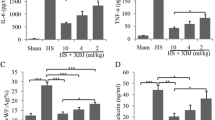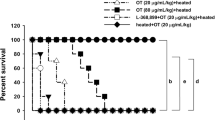Abstract
Purpose
Heatstroke causes systemic inflammation, followed by vascular endothelial damage. The normal vascular endothelium is coated by endothelial glycocalyx (EGCX). Dexmedetomidine (DEX) has an anti-inflammatory effect, but there has been little investigation on the influence of heatstroke on EGCX and the effect of DEX on this condition. Therefore, we examined whether EGCX was disrupted in heatstroke and if DEX improved survival and preserves EGCX.
Methods
Anesthetized Wistar rats were randomly assigned to three groups: a DEX group treated with DEX (5 µg/kg/h) and 0.9% saline infused continuously at 10 ml/kg/h during heat exposure; a NSS group given 0.9% saline during heat exposure; and a SHAM group given 0.9% saline alone without heat exposure. Heatstroke was induced by exposure to an ambient temperature of 40 °C with relative humidity of 60%. The survival rate was assessed up to 2 h after the start of heat exposure. Plasma levels of syndecan-1 and the thickness of EGCX using electron microscopy were measured when the systolic blood pressure fell to less than 80 mmHg.
Results
The survival rate after 2 h of heat exposure was significantly higher in the DEX group compared to the NSS group (89% vs. 22%, P = 0.004). Plasma levels of syndecan-1 were 0.6 ± 1.3, 9.7 ± 5.9, and 2.1 ± 3.4 ng/ml in the SHAM, NSS and DEX groups, respectively (P = 0.013). The thickness of EGCX was significantly higher in the DEX group compared with the NSS group (P = 0.001).
Conclusions
EGCX was disrupted in heatstroke, and DEX improved survival and preserved EGCX.





Similar content being viewed by others
References
Hifumi T, Kondo Y, Shimizu K, Miyake Y. Heat stroke. J Intensive Care. 2018;6:1–8.
Bouchama AKJ. Heat stroke. N Engl J Med. 2002;346:1978–88.
Nakajima Y, Baudry N, Duranteau J, Vicaut E. Effects of vasopressin, norepinephrine, and l-arginine on intestinal microcirculation in endotoxemia. Crit Care Med. 2006;34:1752–7.
Lee WL, Slutsky AS. Sepsis and Endothelial Permeability. N Engl J Med. 2010;363:689–91.
Kataoka H, Ushiyama A, Akimoto Y, Matsubara S, Kawakami H, Iijima T. Structural behavior of the endothelial glycocalyx is associated with pathophysiologic status in septic mice: an integrated approach to analyzing the behavior and function of the glycocalyx using both electron and fluorescence intravital microscopy. Anesth Analg. 2017;125:874–83.
Becker BF, Chappell D, Bruegger D, Annecke T, Jacob M. Therapeutic strategies targeting the endothelial glycocalyx: Acute deficits, but great potential. Cardiovasc Res. 2010;87:300–10.
Chappell D, Westphal M, Jacob M. The impact of the glycocalyx on microcirculatory oxygen distribution in critical illness. Curr Opin Anaesthesiol. 2009;22:155–62.
Sano H, Doi M, Mimuro S, Yu S, Kurita T, Sato S. Evaluation of the Hypnotic and Hemodynamic Effects of Dexmedetomidine on Propofol-Sedated Swine. Exp Anim. 2010;59:199–205.
Kawazoe Y, Miyamoto K, Morimoto T, Yamamoto T, Fuke A, Hashimoto A, Koami H, Beppu S, Katayama Y, Itoh M, Ohta Y, Yamamura H. Effect of dexmedetomidine on mortality and ventilator-free days in patients requiring mechanical ventilation with sepsis. JAMA. 2017;317:1321–8.
Taniguchi T, Kidani Y, Kanakura H, Takemoto Y, Yamamoto K. Effects of dexmedetomidine on mortality rate and inflammatory responses to endotoxin-induced shock in rats. Crit Care Med. 2004;32:1322–6.
Yeh YC, Wu CY, Cheng YJ, Liu CM, Hsiao JK, Chan WS, Wu ZG, Yu LCH, Sun WZ. Effects of dexmedetomidine on intestinal microcirculation and intestinal epithelial barrier in endotoxemic rats. Anesthesiology. 2016;125:355–67.
Xia ZN, Zong Y, Zhang ZT, Chen JK, Ma XJ, Liu YG, Zhao LJ, Lu GC. Dexmedetomidine protects against multi-organ dysfunction induced by heatstroke via sustaining the intestinal integrity. Shock. 2017;48:260–9.
Taniguchi T, Kurita A, Kobayashi K, Yamamoto K, Inaba H. Dose- and time-related effects of dexmedetomidine on mortality and inflammatory responses to endotoxin-induced shock in rats. J Anesth. 2008;22:221–8.
Zhang X-Y, Liu Z-M, Wen S-H, Li Y-S, Li Y, Yao X, Huang W-Q, Liu K-X. Dexmedetomidine administration before, but not after, ischemia attenuates intestinal injury induced by intestinal ischemia-reperfusion in rats. Anesthesiology. 2012;116:1035–46.
Bashandy GM. Implications of recent accumulating knowledge about endothelial glycocalyx on anesthetic management. J Anesth. 2015;29:269–78.
Johansson PI, Stensballe J, Rasmussen LS, Ostrowski SR. A high admission syndecan-1 Level, a marker of endothelial glycocalyx degradation, is associated with inflammation, protein C depletion, fibrinolysis, and increased mortality in trauma patients. Ann Surg. 2011;254:194–200.
Miranda ML, Balarini MM, Bouskela E. Dexmedetomidine attenuates the microcirculatory derangements evoked by experimental sepsis. Anesthesiology. 2015;122:619–30.
Strunden MS, Bornscheuer A, Schuster A, Kiefmann R, Goetz AE, Heckel K. Glycocalyx degradation causes microvascular perfusion failure in the ex vivo perfused mouse lung: Hydroxyethyl starch 130/0.4 pretreatment attenuates this response. Shock. 2012;38:559–66.
Yamakawa K, Matsumoto N, Imamura Y, Muroya T, Yamada T, Nakagawa J, Shimazaki J, Ogura H, Kuwagata Y, Shimazu T. Electrical vagus nerve stimulation attenuates systemic inflammation and improves survival in a rat heatstroke model. PLoS One. 2013;8:e56728.
Liu Z, Wang Y, Ning Q, Gong C, Zhang Y, Zhang L, Bu X, Jing G. The role of spleen in the treatment of experimental lipopolysaccharide—induced sepsis with dexmedetomidine. Springerplus. 2015;4:800.
Okada H, Takemura G, Suzuki K, Oda K, Takada C, Hotta Y, Miyazaki N, Tsujimoto A, Muraki I, Ando Y, Zaikokuji R, Matsumoto A, Kitagaki H, Tamaoki Y, Usui T, Doi T, Yoshida T, Yoshida S, Ushikoshi H, Toyoda I, Ogura S. Three-dimensional ultrastructure of capillary endothelial glycocalyx under normal and experimental endotoxemic conditions. Crit Care. 2017;21:261.
Inagawa R, Okada H, Takemura G, Suzuki K, Takada C, Yano H, Ando Y, Usui T, Hotta Y, Miyazaki N, Tsujimoto A, Zaikokuji R, Matsumoto A, Kawaguchi T, Doi T, Yoshida T, Yoshida S, Kumada K, Ushikoshi H, Toyoda I, Ogura S. Ultrastructural alteration of pulmonary capillary endothelial glycocalyx during endotoxemia. Chest. 2018;154:317–25.
Van den Berg BM, Vink H, Spaan JAE. The endothelial glycocalyx protects against myocardial edema. Circ Res. 2003;92:592–4.
Rehm M, Bruegger D, Christ F, Conzen P, Thiel M, Jacob M, Chappell D, Stoeckelhuber M, Welsch U, Reichart B, Peter K, Becker BF. Shedding of the endothelial glycocalyx in patients undergoing major vascular surgery with global and regional ischemia. Circulation. 2007;116:1896–906.
Mimuro S, Katoh T, Suzuki A, Yu S, Adachi YU, Uraoka M, Sano H, Sato S. Deterioration of myocardial injury due to dexmedetomidine administration after myocardial ischaemia. Resuscitation. 2010;81:1714–7.
Okada H, Kurita T, Mochizuki T, Morita K, Sato S. The cardioprotective effect of dexmedetomidine on global ischaemia in isolated rat hearts. Resuscitation. 2007;74:538–45.
Author information
Authors and Affiliations
Corresponding author
About this article
Cite this article
Kobayashi, K., Mimuro, S., Sato, T. et al. Dexmedetomidine preserves the endothelial glycocalyx and improves survival in a rat heatstroke model. J Anesth 32, 880–885 (2018). https://doi.org/10.1007/s00540-018-2568-7
Received:
Accepted:
Published:
Issue Date:
DOI: https://doi.org/10.1007/s00540-018-2568-7




